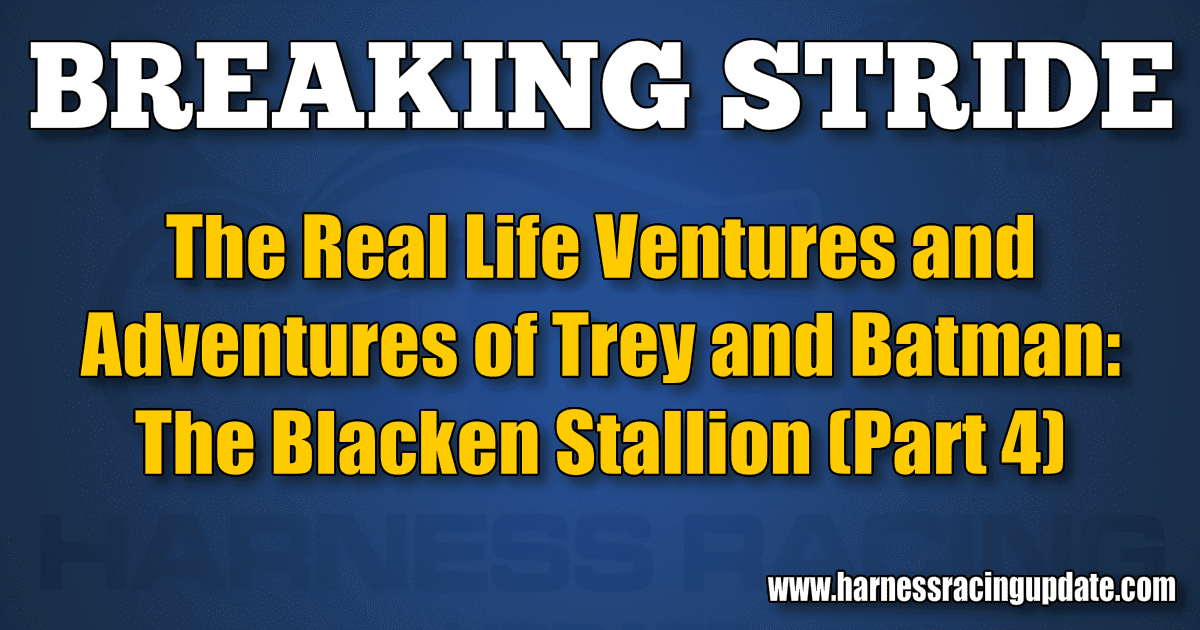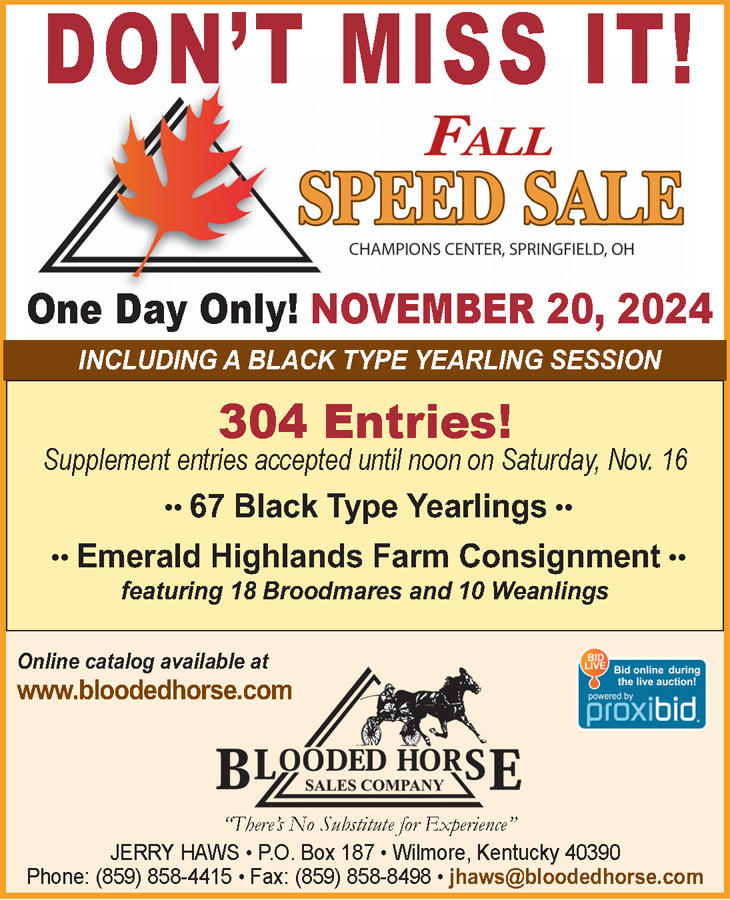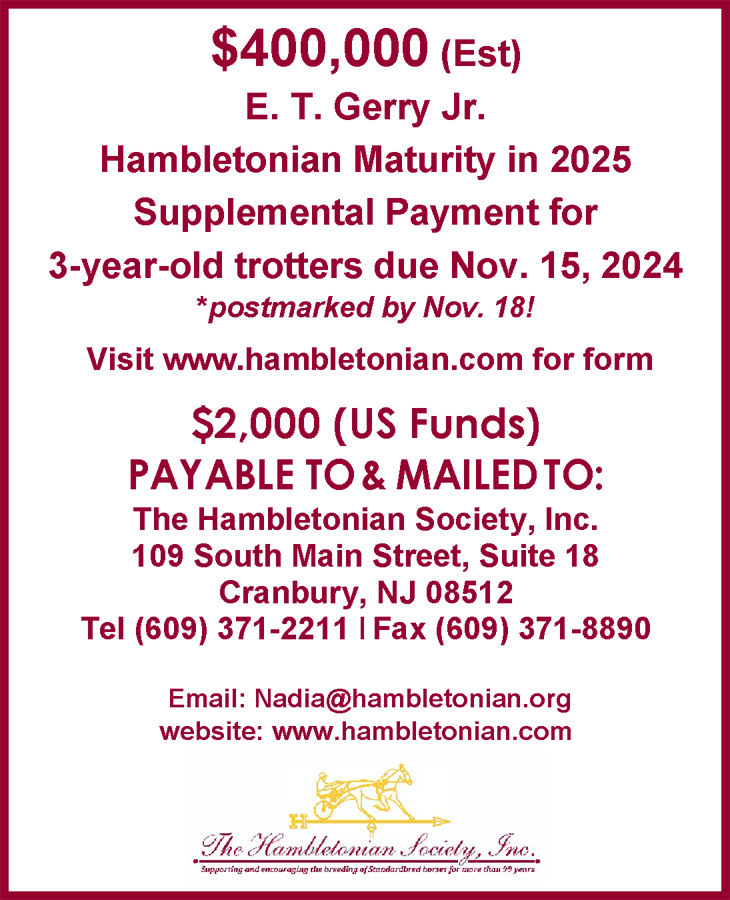The Fibonacci Sequence – The Blacken Stallion (Part 4)
The Real Life Ventures and Adventures of Trey and Batman
by Trey Nosrac
During the second week of March on a raw Tuesday morning, my wealthy friend and I were driving through central Ohio to visit the farm where my pregnant broodmare lives. We grabbed two coffees at a McDonalds Drive Thru, and I turned left, heading down the two-lane blacktop that would take us deep into farm country.
He flipped open the sipping lid of his cream and no sugar coffee and asked, “How did you get involved in breeding a harness horse?”
“The normal progression of gambling, owning, and then breeding.
“Trey normal, that’s shocking. Do tell.”
I ignored his banter and stuck to the subject, “After a few years of losing at the window, a pal and I bought a yearling filly and decided to get rich as owners.”
“How did that go?”
“Actually, not bad; we sold her as a potential broodmare and got a decent price. We took that money and bought a trotting filly, same story. We raced her and sold her as a broodmare.”
“Nice.”
“Yeah, but like most horseplayers, anytime we made a few bucks, we recycled the money back into the game. Our third filly grew into a big Cantab Hall mare. This time we kept her after racing to try the breeding side.”
“And you got rich!”
“Yeah, I live in a double-wide for the ambiance. I drive you around town for the exercise.”
I pulled up the farm address on my GPS and locked it in, “I always get lost on these back roads, they have signs the size of postcards.”
“Which is your favorite part of the sport, gambling, racing or breeding horses?”
I thought a few seconds, “Breeding. Raising a baby horse is interesting as hell, much more complicated than it looks from the outside. Breeding takes a long time, and has just as many pitfalls as gambling or racing.”
“Which brings us back to the big choice for your next sire; who is it going to be, Prestidigitator, Whataworkout or Enterprise?”
“I’m 90 per cent sure, but I still have some time. The broodmare you’re going to meet today is not due until the end of April, maybe early May.”
We drove through the gently rolling hills, past tidy farmhouses and frozen fields.
I broke the silence, “Picking a stallion is easy. The daddy is the only choice a broodmare owner makes for a long time. You just keep your head down and hope the phone doesn’t ring with bad news.”
He tilted his head.
I explained, “You know how when you gamble you can play a pick five, a bet where you need to win five races in a row?”
“Sure”
“Breeding is like a pick-five gamble where you only get one horse in each race. Each step in the process is a yes or no. If the answer is a no you are out. For example, when we order semen from one of these stallions, either my mare gets pregnant or she doesn’t. As a breeder, if you get a no, it’s like having a thirty-year-old kid moving into your attic, a slightly annoying unproductive presence that eats your food for a year.”
“You don’t have kids.”
“I’m speaking metaphorically.”
“Actually, you’re speaking incorrectly. I was an English Major, you used similes.”
“What’s the difference?”
“The difference is the word LIKE. When you said, “Breeding is LIKE a pick five gamble, or when you said. “A mare that is not pregnant is LIKE having a 39-year-old kid move in.’ Using the word LIKE makes the comparisons similes. It’s a small difference.”
“Batman, you are a diphthong, a big diphthong.”
“That’s a metaphor.”
“If you say one more thing about grammar I’ll punch you in the throat. What do you call that sentence Mr. Dead Poet Society?”
“Sarcasm, with a twist of cliché.”
Grinning like kids turned loose at the fair, we exited vaudeville and I returned to breeding, “Getting my mare in foal is winning the first race. Then it continues, the mare carries to birth, yes or no. The foal stands well or it doesn’t. The baby gets sick or stays well. The weanling gets kicked in the field or doesn’t. Maybe the yearling needs a procedure like an OCD removed or not. The yearling gets into the select sale or not. At least two bidders think your yearling is worth your price or not. You need to run the table in the breeding game.”
He nodded, “And these things are all out of your control. For a type A person like me, that would be difficult.”
“For a type Z person like me, I just roll with it and call the ride fate, or karma, or fortune. My thinking is that when I pick a stallion, I feel as if I started the Fibonacci sequence in motion.”
He shook his head, “I don’t think the Fibonacci sequence applies.”
“Don’t start with me, Mr. Big Bang.”
He made a lip-zipping motion.
We had a chuckle and I said, “Plus I enjoy the heck out of visiting the farm, sitting on the porch, and watching the babies grow.”
“And this is how you plan to get rich, breeding a trotter.”
“Hah, I’ll be lucky to get a triple-wide. The thing that trips up amateurs is that we don’t plan on bad things like having a mare abort, but bad things do happen. I’ve only had six or seven babies, but there have been pitfalls. A few years ago, I was talking to a breeder who has been in the business for 50 years. He asked me what I thought the percentage was of mares that are bred, carry to term and have a marketable yearling.”
My friend didn’t guess, he just gave me a shrug.
“My guess was 90 percent.”
“And the answer was?”
“Mid-sixties, and of course plenty of them that are marketable don’t bring what the breeder hopes to get.”
I turned my Prius into the lane that led to the farm. Horses, big and small, young and old raised their heads to take note of the car disturbing their world. I stopped and slid down our windows. We watched the herds as we sipped our coffee and breathed in the crisp, fresh air as the sun suddenly climbed out of the clouds.
I said softly, “Days out here with nature, peace, horses, and friends. This is absolutely the greatest place in the universe.”
He smiled, “That’s hyperbole.”
“Maybe not.”

















